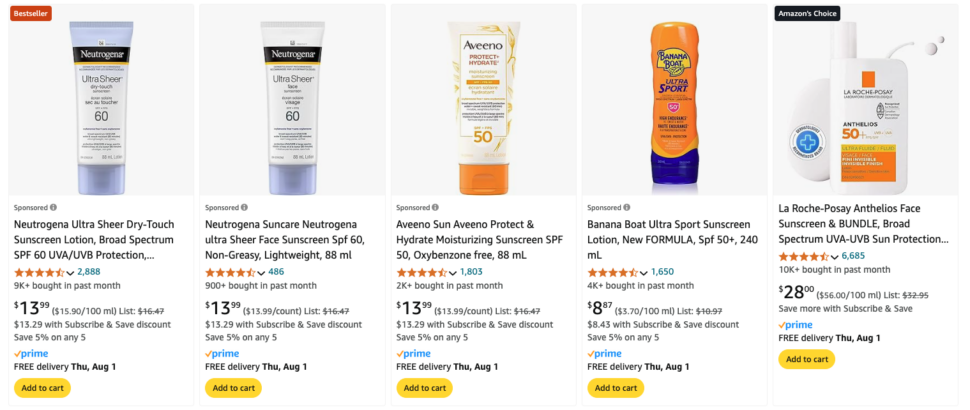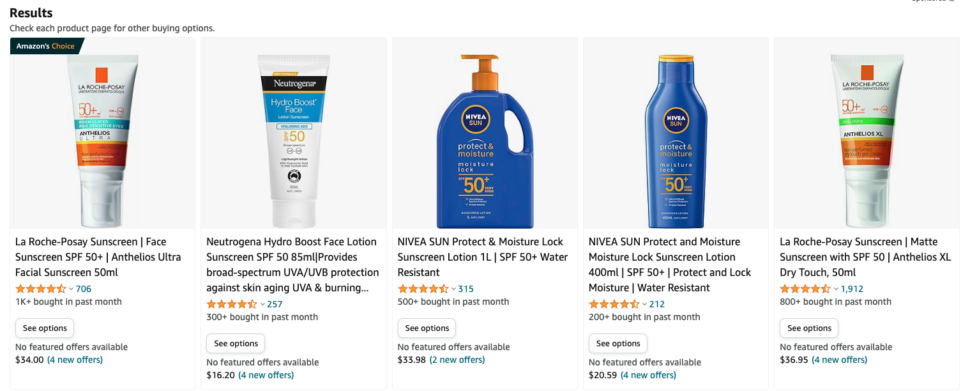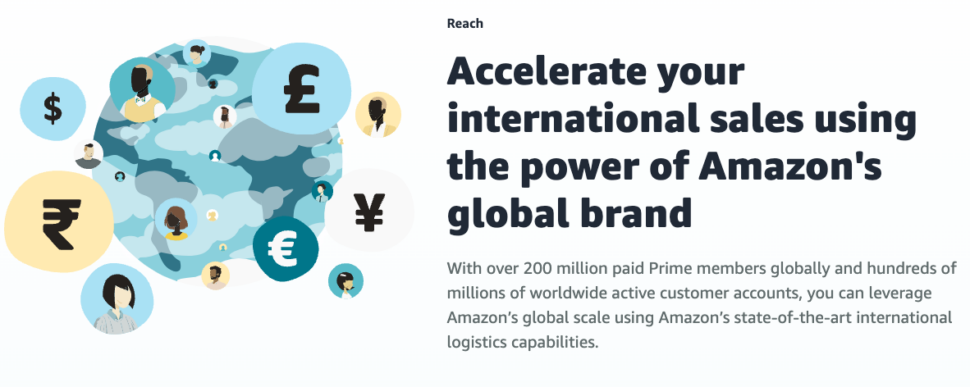Amazon is the world’s most popular e-commerce marketplace with over 2 billion visits per month on average. And while it’s true that 80% of the platform’s 310 million active customers are in the United States, that still leaves a whopping 62 million users spread around the world.
Amazon’s global expansion now has it shipping to 100 countries. Apart from the U.S., it also operates distinct country-specific websites in 19 other countries across most of the English-speaking world as well as in Europe, Asia, and Africa.
The full list of global Amazon websites includes:
While there’s no count of exactly how many multinational brands are on Amazon, you will find almost all of them there. That includes tech giant Apple, gaming pioneer Nintendo, and fitness phenom Lululemon.
In this article, we’ll dive into how to expand your Amazon e-commerce business into different countries and marketplaces. Maybe you’re a Canadian seller hoping to expand into Europe, or a Chinese seller trying to reach an American audience.
We’ll explore how to set up Amazon stores in new markets, how to prepare yourself for success by adapting your listings and content for cultural considerations, as well as how to validate different branding and product strategies in these international e-commerce stores.
The sheer volume of international shoppers and easy access to new customers in diverse markets makes Amazon a great option for expansion, no matter your business size or the type of products you offer.
Benefits of international expansion
The benefits of expanding your Amazon business to international audiences seem self-explanatory on the surface – more markets bring more customers and more sales. But these benefits are amplified by the unique nature of new markets.
Less competition

For U.S. Amazon sellers especially, other countries offer less competition. One of the highest-selling products on Amazon in 2024 so far is baby monitors. There are over 7,000 baby monitors listed on Amazon.com, but only 2,000 listed on Amazon.com.au in Australia. This makes it easier to cut through the noise and stand out.
Diversity and risk mitigation


International markets add diversity. Just like in investing, diversifying is good for business because it minimizes risk and reduces the impact of seasonal swings. One big benefit of selling in different markets is being able to sell year-round. If you have a seasonal item like sunscreen, for example, selling it in regions across both hemispheres helps keep your sales more stable.
The diversity of markets also means you’re better insulated against local economic or environmental factors. If a regulation, tax rate, or even just a downturn in consumer spending hits one market, your other markets help soften the impact.
International branding
Amazon has a worldwide reach, and savvy businesses can use that reach to develop a trusted international brand profile.
Expanding your Amazon store across borders can give you more name recognition and legitimacy. Since your original customer reviews will stay with your brand, your positive reviews on one Amazon site will help legitimize your store as you enter new or emerging markets.
How to expand on Amazon

Amazon makes it easy to expand your e-commerce store to different markets using your Amazon seller or Amazon FBA account.
Detailed instructions for global selling on Amazon are available on their website. The procedure differs slightly by region. Let’s take a crash course in expanding your Amazon marketplace globally:
How to sell to Canada and Latin America with an Amazon seller account
You can sell to Canada, Mexico, and throughout Latin America using your existing North American Unified Seller account without creating a new seller account.
If you’re using a global account from another region, you can create a North American seller account and then link the two accounts.
You can create, edit, manage, and even translate your listings using the Build International Listings tool.
If you’re a Fulfillment by Amazon (FBA) seller, then everything is effectively plug-and-play. If you have your own fulfillment systems, you’ll need to set up distribution centers in your new country.
How to sell in Europe with an Amazon seller account
Many Amazon.com sellers are already equipped to ship to Europe using the FBA Export program; however, this doesn’t mean your products are listed on country-specific Amazon marketplaces in Europe.
To access these, you’ll need to set up a global seller account with a European Amazon site. You can then link this account to your primary Amazon seller account for ease of management.
How to sell in the Asia-Pacific region with an Amazon seller account
It’s easy to set up an account with Amazon in Singapore or Japan. You can then link that account to your U.S. or global Amazon seller account and use the “Build International Listings” tool to sync and manage your accounts.
In Australia, you’ll need to set up a Seller Central account with Amazon.com.au, and go through some paperwork specific to Australian commerce regulations. From there, you can sync and manage your listings with your U.S. seller account.
To sell in India, Amazon stores need a specific Indian Amazon seller account. This will involve seller identity verification, carrier onboarding, and updating your bank details. At this time, there is no FBA system in India and you can’t connect your account to your U.S. account.
How to sell in the Middle East with an Amazon seller account
Sellers can expand to the Middle East by setting up a Saudi Arabian or U.A.E. seller account. Just like North America, Europe, and most of the Asia-Pacific region, Amazon allows sellers in the Middle East to link their account to a U.S. Amazon seller account and use the “Build International Listings” tool to easily update and create Amazon product listings.
Now that we’ve discussed how to set up or link your Amazon seller account to a new market, let’s jump into other considerations when expanding globally.
Things to consider for global expansion
Expanding into new Amazon markets can be daunting, but a little forethought and planning makes the process much simpler.
Here are some of the key factors to consider when you’re planning your Amazon expansion:
Shipping times and costs
As an international seller, your big challenge is meeting shipping expectations and timelines while keeping costs low. Amazon FBA sellers have an advantage here as there are fulfillment centers spread across the globe, which operate almost autonomously. Amazon claims its FBA costs are around 30% cheaper than regular shipping costs – even in foreign markets.
FBA also handles large parts of the supply chain and inventory management process so you don’t have to.
Shopping holidays
Prime Day isn’t the same in every country. Other countries don’t traditionally shop on Black Friday like the U.S. does on Thanksgiving weekend. In places like Australia, Boxing Day is the big holiday doorbuster day for sales. Make sure you know the important shopping holidays for each country so you can take advantage of them.
Government regulations
Regulations on e-commerce and other businesses vary by region. Taxation is one obvious difference between countries, but there are also bans on specific imports to different nations.
For example, Australia bans the import of most animal-based products and many plant products to help the fight against invasive species. In Canada, there are restrictions on electrical equipment that doesn’t comply with its product safety regulations.
In Europe, sellers are required to provide product information in the local market it is being listed in. So if you’re listing something in Poland, it needs to be shown in Polish; in Spain, Spanish, and so on.
Understanding the import restrictions and other regulations in your target market is important, as stiff penalties apply if you miss this information. You can use a third-party consultant to help navigate any potential issues.
Different cultures and buying habits

Obviously, every nation and culture is unique, and each has different expectations, tastes, and values when it comes to shopping. For example, in the U.S., cheaper is usually better, while in other markets, shoppers look for higher-end goods.
In China, red is a lucky color to the point that it influences product packaging and design. Thirteen is an unlucky number in many Western cultures, but in other cultures four is unlucky. Understanding these cultural differences can prevent you from accidentally alienating buyers.
Tips for a successful Amazon expansion
Opening an Amazon store in another country is easy. Actually selling successfully takes some planning and organization.
For sellers in some countries (China, for example), Amazon is making it more difficult to compete with other sellers on price due to increased fees. Because of that, sellers are turning to other strategies for helping their listings stand out — including building stronger brands and focusing on listing optimization.
Here’s how to make your Amazon empire a success:
Competitive analysis
Growing any Amazon sales empire requires careful analysis of the market – but it’s even more important in markets that are new to you. Before you do anything, make sure you understand the lay of the land. Things to understand include:
- Existing products in your segment
- Market size and trends
- Competitive landscape
Find out what similar products are on offer in the market you want to set up shop in, and how they’re performing. Is the market growing or shrinking? What sort of seasonal trends impact sales in this market? Lastly, what are the pricing trends in that marketplace?
You can use PickFu’s Amazon Competitor Test to assess why customers respond to existing products and why, even before you begin setting up a store in that region.
Optimize and localize your listings
Not only is it important to translate product listings into the local language, but sellers should make sure their translations are relevant to the region. It’s too easy to make a linguistic error that inadvertently offends customers with rude words, or use awkward, ambiguous phrasing.
That’s why testing your product titles and descriptions with real people in your target audience is so important – it helps with accurate localization and ensures your content is appropriate for your new customer base.
A bad product description can create a subpar or negative experience for a potential buyer. By testing your product description in the country you want to expand into, you’ll ensure it resonates with customers and drives more conversions.
An Amazon Page Review test can show you which aspects of your product listing and description are confusing or off-putting for potential customers. PickFu lets you run these types of tests easily against their built-in, vetted consumer panel – including audiences across the globe.
Customize product images or designs
The colors, fonts, or even images that resonate with U.S. buyers won’t always work in other countries.
Let’s say you have a camping goods store on Amazon and all your branding and product images are filled with bald eagles and American flags. This imagery probably won’t be well-received in Japan or Australia.
Be mindful of the market you’re entering, and test a selection of product images to make sure they work in your new market.
This is another common test that e-commerce sellers run with PickFu – optimizing their Amazon main image by having consumers vote for their favorite version and give feedback on what they like and dislike.
How to validate your Amazon products and brands with PickFu
We already touched on some of the Amazon testing templates available in our library of polls, including these:
Conducting rapid research about Amazon shopper preferences is easy on PickFu. We even have an Amazon Mockup Generator that lets you create hypothetical listings to test before expanding globally.
PickFu is a consumer research platform that lets you run polls and surveys against your target audience. Amazon sellers use it to iteratively test their branding, products, and listings – from brand perception to product designs to the specific wording of headlines or product descriptions. When your tests are done, you’ll have clear, actionable data and insights from real consumers.
Let’s walk through a PickFu survey example that evaluates an Amazon category and brand across two different markets: the U.S. and Japan.
Step 1: Amazon product title comparison
First, we asked users to choose from two different product titles for a dog life jacket. We conducted the survey against built-in audiences in both the U.S. and Japan to see how each market would react.
As you can see in the image above, U.S. consumers chose Option A as the best product title. Japanese consumers also chose option A, scoring it 80-20.
(You can also see in this example the way that PickFu automatic translation asks questions in the native language of the region you’re testing in, and then translates back to English for your results.)
There were some interesting nuances to the different choices, though. In the U.S. survey, comments focused on the detail offered in the description and the apparent brand trustworthiness of the name.
In Japan, however, specific features stood out as more appealing.
Using these audience insights can help you write a more effective product listing tailored to the subtle tastes and differences of each market.
Step 2: test your branding, images, and A+ content
Next, we ran a Star Rating test asking the panels to rate a product image used in our Amazon image stack for the dog life jacket.
Conducting international brand audits like this – testing your logo, brand name, product images, A+ content, etc. – helps you discover how different audiences perceive your brand and product. Since this can vary widely between countries, these are very important tests to run!
Some of the comments from the Japanese panel included:
- “It’s cute and I’d love to buy it, but I’d also love to see a picture of it actually floating!”
- “It gives an image of wearing it, but I think it would be more convincing if it were actually swimming.”
- “The design and colors are easy to recognize, but the dogs are almost evenly sized. It is difficult to understand the type of size.”
Based on that feedback, it would be a good idea to add images showing the dogs wearing the life jackets in the water, as well as a greater variety of dog breeds.
By testing your product images, you’ll discover how effective your information, branding, and designs are. With each PickFu test, you’ll not only get quantitative data, but qualitative insights about respondents’ likes and dislikes (as well as suggestions for where to improve or next steps to take).
Step 3: Amazon competitive analysis
Finally, we ran a Click Test asking the audience which dog life jacket they’d be most likely to click on in the Amazon search results page. This is a great way to evaluate how your product compares against your top competitors – do you stand out in the SERP? And is it different across different countries?
In the U.S., most users preferred the Doberman in the red life jacket:
This is contrasted by the results among Japanese customers, who didn’t click on the Doberman at all, but responded to the cuter and softer images:
What this should tell you is that it’s important to adjust your listings for each market’s unique preferences. What’s important to a western or American audience might not resonate at all with a Japanese one. Running tests like this before you launch can help you have the greatest chance of success from the beginning.
After you launch, it’s important to continue monitoring and reviewing your performance in new markets closely. This includes checking customer feedback, monitoring sales, and even checking things like your click-through and sell-through rate on your listings.
PickFu surveys and polls are a great way to quickly validate your product content and design throughout this process. If you do see a drop in performance or negative feedback, use PickFu to test a solution before you deploy an updated design or product description.
Let PickFu guide your global Amazon expansion
PickFu supports quick and easy user testing as well as listing validation in new markets because it allows you to target a built-in audience of global consumers. There’s no better way to test and validate your:
- Amazon product listings
- Main image & image stack
- A+ content
- Amazon product headlines
- Amazon product descriptions
You can gather feedback on all these elements and more from target customers in multiple countries before you even launch. And features like auto-translation make gathering feedback from international audiences easy. With test templates for a range of product development and market research uses, PickFu is the fastest and easiest way to gather user feedback and optimize your Amazon listings in multiple countries.
Sign up for a PickFu account for free and start your successful Amazon global expansion today!
Amazon Global Expansion FAQs
What are the key factors that have contributed to Amazon’s success in global markets?
Amazon’s success lies in its convenience to online shoppers, but also in its extremely complex and robust shipping and fulfilment infrastructure. Amazon has made an industry out of helping small and medium businesses as well as big brands access international markets with ease.
What is e-commerce fulfillment?
E-commerce fulfillment is the shipping process that makes sure orders get into the hands of the people who asked for them. Amazon Prime shoppers usually receive orders fulfilled by Amazon. These FBA orders often deliver a better customer experience because they are shipped quickly and reliably.
What are the risks of international expansion on Amazon?
The biggest risk of taking your e-commerce market international is in failing to provide the right customer experience. This may be a function of poor supply-chain planning or because your product is unsuited for local tastes and culture. It’s also risky to deploy headlines, product descriptions, or even images without testing them to see how they resonate with your audience. Lastly, there’s a risk of accidentally breaking local regulations and rules. To mitigate these risks, consult a third party for local legal help, and validate your product content using a customer insight platform.
How do I make passive income on Amazon?
International markets are how to make passive income on Amazon more efficiently. These new customers and more diverse markets increase sales and reduce risk for Amazon resellers.



